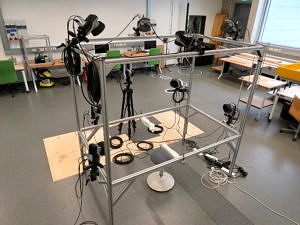motion capture laboratory
Our motion analysis lab (DFG proposal for major instrumentation INST 90/985-1) is equipped with a camera and marker based optical tracking system with 10 Qualisys MoCap high speed cameras and 2 Qualisys high speed video cameras Noraxon MyoMotion Research Pro 16, Inertial Sensors, Cyberglove III to measure hand joint angle kinematics, force plates, and Noraxon Desktop DTS electromyography sensors.
To perform motion capturing for small human actions, such as motion of hand digits, a frame was constructed to bring the cameras closer to the markers. With this setup, kinematic parameter identification for joints in the human hand, especially the wrist, the metacarpophalangeal and interpalangeal joints has been performed. This is an essential first step towards formulating a procedure for effective parameter identification to setup subject-specific models. This will enable us to perform biomechanical optimal control simulations with higher levels of confidence and use the results as measures of human performance.

